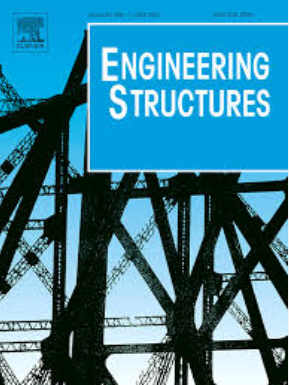Strain-based performance evaluation of planar flexural reinforced concrete walls
IF 5.6
1区 工程技术
Q1 ENGINEERING, CIVIL
引用次数: 0
Abstract
This study enables the prediction of seismic damage to planar flexural reinforced concrete (RC) walls by using a simple numerical tool. Strain limits for concrete and longitudinal reinforcement are established for the conceptual damage levels (damage levels I, II, III, and IV) outlined in the Japanese guidelines for post-earthquake damage evaluation. The strain limits are validated against experimental data from 27 previously tested RC wall specimens with different geometry-, section-, loading-, and material-related parameters, using a force-based beam-column element model with a modified Gauss-Radau plastic hinge integration rule and regularized material models. The results indicate that experimental damages at the drift ratio corresponding to the proposed strain limits align with the damage descriptions of the specified damage levels. The drifts at the proposed strain limits are compared with those obtained using the acceptance criteria for the three performance levels (IO, LS, and CP) in ASCE/SEI 41–23 to give a tentative understanding of their alignment with established performance standards.
求助全文
约1分钟内获得全文
求助全文
来源期刊

Engineering Structures
工程技术-工程:土木
CiteScore
10.20
自引率
14.50%
发文量
1385
审稿时长
67 days
期刊介绍:
Engineering Structures provides a forum for a broad blend of scientific and technical papers to reflect the evolving needs of the structural engineering and structural mechanics communities. Particularly welcome are contributions dealing with applications of structural engineering and mechanics principles in all areas of technology. The journal aspires to a broad and integrated coverage of the effects of dynamic loadings and of the modelling techniques whereby the structural response to these loadings may be computed.
The scope of Engineering Structures encompasses, but is not restricted to, the following areas: infrastructure engineering; earthquake engineering; structure-fluid-soil interaction; wind engineering; fire engineering; blast engineering; structural reliability/stability; life assessment/integrity; structural health monitoring; multi-hazard engineering; structural dynamics; optimization; expert systems; experimental modelling; performance-based design; multiscale analysis; value engineering.
Topics of interest include: tall buildings; innovative structures; environmentally responsive structures; bridges; stadiums; commercial and public buildings; transmission towers; television and telecommunication masts; foldable structures; cooling towers; plates and shells; suspension structures; protective structures; smart structures; nuclear reactors; dams; pressure vessels; pipelines; tunnels.
Engineering Structures also publishes review articles, short communications and discussions, book reviews, and a diary on international events related to any aspect of structural engineering.
 求助内容:
求助内容: 应助结果提醒方式:
应助结果提醒方式:


